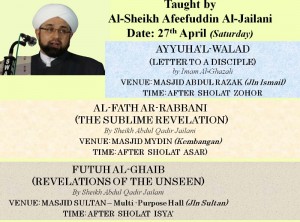From Coursework on Tasawwuf
Al-Fatihah (Protection from Astray)
صِرَٰطَ ٱلَّذِينَ أَنْعَمْتَ عَلَيْهِمْ غَيْرِ ٱلْمَغْضُوبِ عَلَيْهِمْ وَلَا ٱلضَّآلِّينَ (٧)
The path of those upon whom You have bestowed favor, not of those who have evoked [Your] anger or of those who are astray.
Hadith Qudsi
Among the many definitions given by the early scholars to Sacred Hadith is that of as-Sayyid ash-Sharif al-Jurjani (died in 816 A.H.) in his lexicon At-Tarifat where he says: “A Sacred Hadith is, as to the meaning, from Allah the Almighty; as to the wording, it is from the messenger of Allah (peace and blessings of Allah be upon him). It is that which Allah the Almighty has communicated to His Prophet through revelation or in dream, and he, peace be upon him, has communicated it in his own words.”
Sunnah
It is not allowed to tawassul (asking to beseech Allah) to Prophet Muhammad. But we are allowed to gain syafaah (intercession) from him due to the fact that we are his Ummah who sends Selawat (blessed salutation) upon him.
Tawassul to Allah via 3 ways
1. One’s righteous deeds (amal)
2. Recitation of Asma’ul Husna
3. Through the doa of righteous (‘alim) others for us
Sunnah is not Shirk. Tawassul is Shirk.
Reason why Muslims tawassul to Prophet is due to fabricated hadith that Allah created this world with the light of Muhammad. Truth is no one can seek help from a deceased including our Prophet.
Stick to Rope of Allah
1. Hold to kalimah Laa ilaaha illaah.
2. Kalimah Tawheed.
Bearers of Truth (Haq)
1. Companions, Followers, Imams, Scholars
2. First to be resurrected is Prophet Muhammad.
3. Inhabitants of heaven total 120 saf (80 from Prophet Muhammad’s Ummah, the rest from followers of other Prophets).
4. 70,000 enter heaven without reckoning (hisab) and azab (punishment)
Deviance from Tawheed
1. Rububiya – do not believe that Allah is the only Lord and Creator
2. Uluhiya – do not believe that Allah alone deserves to be worshipped
3. Asmaa Was Sifaat – do not believe in Allah’s 99 Names and Attributes
4. Haakimiya – do not believe that Allah is the only lawgiver
Jamat al-Tabligh
1. Origins: India
2. Daily practice: Reading of the Fadhail Amal (mainly weak hadith – daif, strictly follow Sunnah Az-Zawaid (jubah, siwak, eat with hands, eyeliner, beard, etc), 40 days Dawah (similar to seclusion before revelation of Prophet Moses)
3. Method of Dawa’: putting ‘fear’ into the person’s heart because their aim is to instil faith in Allah and continuously remind its followers of the necessity of constantly increasing one’s faith through good actions; therefore they non apolitical
Ahlul Bayt
1. Focus on Imamiyah from the line of Caliph Ali. The Tariqat’s founder was Al-Sayyid Al-Faqih Muhammad bin Ali BaAlawi Muqaddam Alhusaini.
2. The Tariqat of Al-BaAlawi Tariqat is one of the Tariqats of Ahlul Bait. Its outer aspect is as explained by Imam Ghazali in his books such as ‘Bidayah al-Hidayah, Ihya Ulumuddin and Minhaj al-Abidin, namely about knowledge which fits with the true Manhaj (way). Its inner aspect is like that described by followers of Syadziliyyah (another Ahlul Bait Tariqat), achiving the truth and purity of Tauhid, unity of God.
3. Features: always be in the state of abolution, Witir prayer, Duha prayer (2-8 cycles), Ratib al-Attas or Ratib al-Haddad recited before sleep, practices not to curse, talk behind other people’s back and make complains, never interfere in the public’s problem unless to improve, teach or delight never getting involved in doubtful things and unjustness, be careful in mixing, especially against fraudulent people and those who like to twist tales, do not like touching the dignity of others, or take other people’s wealth without right, fear Allah and keep away from things that could damage or tarnish their characters, always seek the pleasure of Allah, doing what is asked and leaving what is forbidden , their time is always filled either with education, exchanging views among friends, teaching, guiding, studying the Quran or doing prayers, if sitting with family and children, they are friendly, jovial, teaching with gentleness. Whoever did good they return with kindness. If unable to repay, they will delight the heart by praying for them (those who did good)
Faces of Sufism
1. Qadariyyah
http://www.daruljailani.net/
Murshid: Shaykh Afeefuddin, Ustaz TM Fouzy
2. Azizah Chisty
PRESENT COURSES/LESSONS
http://www.azizahchishty.com
Murshid: Ustaz Iqbal Abdullah
3. Naqsbandi
http://www.simplyislam.sg
Murshid: Shaykh Muhammad Hisham Al-Kabbani, Shaykh Nazim Haqqani
4. Ahmadiyyah Idrissiyyah
http://www.ahmadiah-idrisiah.com
Murshid: Ustaz Hasbi Hassan
Extreme Reactions to Sufism & Its Connection to Salafism
Ibn Abd al-Wahhab was inspired by Ibn Taymiyyah, a 14th-century scholar and dedicated Sufi, who is however remembered mainly as an outspoken critic of the excesses of certain schools of Sufism during his time. (Wikipedia)
Wahhabism is an ultra-conservative branch of Sunni Islam among fundamentalist Islamic believers, with an aspiration to return to the earliest fundamental Islamic sources of the Quran and Hadith, with inspiration from the teachings of Medieval theologian Ibn Taymiyyah and early jurist Ahmad ibn Hanbal.
Extremism is not Sunnah
Example. Taliban (has Sufi & Deobandi roots) is an example of the extreme version of Tabligh
PROBLEM: AGGRESSION, TRUTH OR MEDIA? AL-QAEDA DOES NOT EXIST!
Example. Shia is an example of the extreme version of Tariqah Ahlul Bayt?
Wahabism/Salafism/Sufyanism is an example of the extreme version of Sufism?
WAR ON TERROR?
Example. Afghanistan – strategic location from Europe leading to Middle East and South East Asia
Aim: territorial conquest?
Example. Pakistani Muslims & Indian Hindus are not on peaceful terms due to land. With internal struggle, they need to buy weapons of destruction from the West
Aim: land resource and power?
DA’WAH OF PROPHET MUHAMMAD
1. Non-Muslim countries fell to Islam in the past during the battles of Prophet
2. Wars and fights continue till today because they want to gain back their lands
3. However Muslims will not let it happen because they do not want their lands to return to being Kafirun and have their rights taken away
CONCLUSION
1. Islam is peace and co-existence among Muslims and Non-Muslims
2. During the time of Prophet Muhammad, Muslims, Jews and Christians live together
3. Muslims ruled by Muslim law and Non-Muslims are bounded by their own laws
References:
http://islam.uga.edu/dawah_tariqat_sa.html
http://www.shiar-islam.com/english/edoc28.htm
http://www.ahmadiah-idrisiah.com













Aslmkm braders , why is it not mention my teacher, allahyarham al allama alimmatul labor, al wali as shahir al qutubul wahid sidi sheik abd rashid bin sidi sheik muhammad said all lnggi